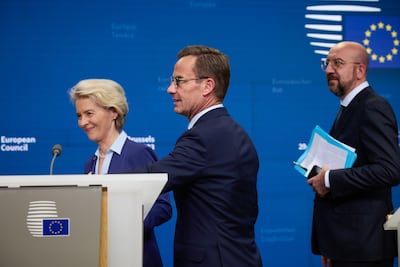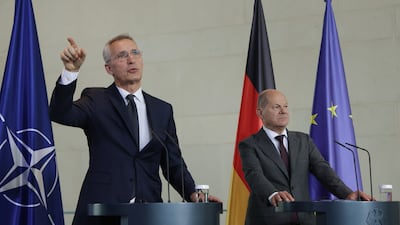As recently as the Nagorno-Karabakh conflict of 2020, the advent of drone warfare was seen as bad for tanks and particularly detrimental for the future of artillery formations.
Ukraine, with its long front line where two fully formed armies are waging battle, changed all that – even as drones played a leading role in the fight, the shelling is what shapes the battle.
The Nato alliance holds its annual summit next week in Lithuania and the obvious question is: what are the members doing about establishing an artillery edge in Europe?
It appears the answer is not yet clear and that goes to the heart of the alliance’s seriousness as the foremost military bloc in the world.
Ursula von der Leyen, President of the European Commission, announced a rapid investment in output of artillery shells earlier this year. She said anything was possible.
The actual systems that deliver these shells are in short supply too, and Nato’s defensive plans for Europe revolve around these challenges. It is at the heart of how the alliance intends to fight.
Confidence in Europe’s rearmament relies on Nato’s leadership getting the big guns out of the factories sooner rather than later
There has been plenty of talk about learning the lessons of the successes Ukraine has racked up on the battlefield against what was thought to be a superior enemy.
For example, Ukraine won praise last week from the International Institute of Strategic Studies. In a report it said Kyiv had “rapidly incorporated foreign weapons and technology”, specifically mentioning the deployment of the US Himars precision rocket artillery. It pointed out the enabling factors that Ukraine had been able to put around the systems, often by improvisation, such as buying the Chinese-made DJI drones.
Europe’s land armies are now looking at this response as the key to its upgraded priorities.
Even before the Russian invasion of its European neighbour, the question posed for Nato was summed up by French President Emmanuel Macron’s jibe in 2019 that the organisation had become "brain dead".
Just the summer before the Ukraine war, Nato operations were exposed to strategic failure by the collapse in Afghanistan, which had been its most ambitious mission this century.
Don’t forget the impact on many Mena countries of the 2011 intervention in Libya that has not produced a better outcome.
The legacy of these conflicts, and the role of leading Nato states in Iraq, was to bend the alliance out of shape. Military planners' jargon had every sinew stretching to develop a light-footprint expeditionary operation model of war fighting. Now the switch to a more conventional configuration for war fighting in Europe remains a goal but not yet the face of European military power.
Equipment and structures are still far behind where planning scenarios envisage. Training is the third leg of this framework and also lags
The IISS report lists the battle tanks, fighting infantry vehicles, self-propelled artillery and other systems that are currently part of more than a dozen Nato countries' militaries. The numbers for most are listed in the dozens or low hundreds.
As Ms von der Leyen said in February, what is needed to upgrade the output of artillery ammunition alone in Europe is to move mountains.
In May she returned to her message saying the Commission was still pushing the armaments industries to “ramp up” production.
Last week, Ms von der Leyen was welcoming the next piece in the puzzle for the Europeans. The common procurement initiative, known as EDIRPA, will use the EU budget to spend €300 million ($326 million) on arms purchases for member states. One of the avowed goals of the initiative, a quid pro quo, is that one third or more of national defence spending should be devoted to pan-EU programmes.
The architects of the scheme foresee three benefits: stopping the fragmentation of European buying power, boosting investment in the local ramp up and providing market strength to the additional defence spending.
All that is for the long term. The immediate need is to sign contracts and here the record is less impressive than the scroll of names given to these systems. Names like Starstreak, Boxer, Jaguar and Archer look very impressive in press releases. Often the numbers of each put on order are packing less of a punch.
What this is all about is readiness. An announcement last month from Germany should serve as wakeup call of a rising benchmark. Berlin said it wanted to station a “permanent, robust” force around 4,000 troops to Lithuania to strengthen the alliance’s eastern flank.
German Defence Minister Boris Pistorius made the statement in the Lithuanian capital of Vilnius. The timing ahead of the Nato summit in the same city next week was clearly a vote of confidence in Nato’s new-found virility.
It is also quite a step change from what was called the high readiness rotating task force model that had been deployed as a kind of souped-up military exercises since the Baltic and Eastern European states joined the Nato expansion 15 years ago. The deterrence effect of this approach was touted after the 2014 Russian annexation of Crimea and the Donbas but proved nothing of the sort.
Beware when listening to pledges of a military build-up that prioritises battlefield iron and steel just as much as tech. In the wake of the Wagner rebellion that shook the Kremlin, the share prices of big arms manufacturers like Germany’s Rheinmetall suffered falls as investors feared a quicker resolution in Ukraine.
Confidence in Europe’s rearmament relies on Nato’s leadership getting the big guns out of the factories sooner rather than later.
The specs
Engine: 2.0-litre 4cyl turbo
Power: 261hp at 5,500rpm
Torque: 405Nm at 1,750-3,500rpm
Transmission: 9-speed auto
Fuel consumption: 6.9L/100km
On sale: Now
Price: From Dh117,059
SPEC%20SHEET%3A%20NOTHING%20PHONE%20(2)
%3Cp%3E%3Cstrong%3EDisplay%3A%3C%2Fstrong%3E%206.7%E2%80%9D%20LPTO%20Amoled%2C%202412%20x%201080%2C%20394ppi%2C%20HDR10%2B%2C%20Corning%20Gorilla%20Glass%3C%2Fp%3E%0A%3Cp%3E%3Cstrong%3EProcessor%3A%3C%2Fstrong%3E%20Qualcomm%20Snapdragon%208%2B%20Gen%202%2C%20octa-core%3B%20Adreno%20730%20GPU%3C%2Fp%3E%0A%3Cp%3E%3Cstrong%3EMemory%3A%3C%2Fstrong%3E%208%2F12GB%3C%2Fp%3E%0A%3Cp%3E%3Cstrong%3ECapacity%3A%3C%2Fstrong%3E%20128%2F256%2F512GB%3C%2Fp%3E%0A%3Cp%3E%3Cstrong%3EPlatform%3A%3C%2Fstrong%3E%20Android%2013%2C%20Nothing%20OS%202%3C%2Fp%3E%0A%3Cp%3E%3Cstrong%3EMain%20camera%3A%3C%2Fstrong%3E%20Dual%2050MP%20wide%2C%20f%2F1.9%20%2B%2050MP%20ultrawide%2C%20f%2F2.2%3B%20OIS%2C%20auto-focus%3C%2Fp%3E%0A%3Cp%3E%3Cstrong%3EMain%20camera%20video%3A%3C%2Fstrong%3E%204K%20%40%2030%2F60fps%2C%201080p%20%40%2030%2F60fps%3B%20live%20HDR%2C%20OIS%3C%2Fp%3E%0A%3Cp%3E%3Cstrong%3EFront%20camera%3A%3C%2Fstrong%3E%2032MP%20wide%2C%20f%2F2.5%2C%20HDR%3C%2Fp%3E%0A%3Cp%3E%3Cstrong%3EFront%20camera%20video%3A%3C%2Fstrong%3E%20Full-HD%20%40%2030fps%3C%2Fp%3E%0A%3Cp%3E%3Cstrong%3EBattery%3A%3C%2Fstrong%3E%204700mAh%3B%20full%20charge%20in%2055m%20w%2F%2045w%20charger%3B%20Qi%20wireless%2C%20dual%20charging%3C%2Fp%3E%0A%3Cp%3E%3Cstrong%3EConnectivity%3A%3C%2Fstrong%3E%20Wi-Fi%2C%20Bluetooth%205.3%2C%20NFC%20(Google%20Pay)%3C%2Fp%3E%0A%3Cp%3E%3Cstrong%3EBiometrics%3A%3C%2Fstrong%3E%20Fingerprint%2C%20face%20unlock%3C%2Fp%3E%0A%3Cp%3E%3Cstrong%3EI%2FO%3A%3C%2Fstrong%3E%20USB-C%3C%2Fp%3E%0A%3Cp%3E%3Cstrong%3EDurability%3A%3C%2Fstrong%3E%20IP54%2C%20limited%20protection%3C%2Fp%3E%0A%3Cp%3E%3Cstrong%3ECards%3A%3C%2Fstrong%3E%20Dual-nano%20SIM%3C%2Fp%3E%0A%3Cp%3E%3Cstrong%3EColours%3A%3C%2Fstrong%3E%20Dark%20grey%2C%20white%3C%2Fp%3E%0A%3Cp%3E%3Cstrong%3EIn%20the%20box%3A%3C%2Fstrong%3E%20Nothing%20Phone%20(2)%2C%20USB-C-to-USB-C%20cable%3C%2Fp%3E%0A%3Cp%3E%3Cstrong%3EPrice%20(UAE)%3A%3C%2Fstrong%3E%20Dh2%2C499%20(12GB%2F256GB)%20%2F%20Dh2%2C799%20(12GB%2F512GB)%3C%2Fp%3E%0A
Key figures in the life of the fort
Sheikh Dhiyab bin Isa (ruled 1761-1793) Built Qasr Al Hosn as a watchtower to guard over the only freshwater well on Abu Dhabi island.
Sheikh Shakhbut bin Dhiyab (ruled 1793-1816) Expanded the tower into a small fort and transferred his ruling place of residence from Liwa Oasis to the fort on the island.
Sheikh Tahnoon bin Shakhbut (ruled 1818-1833) Expanded Qasr Al Hosn further as Abu Dhabi grew from a small village of palm huts to a town of more than 5,000 inhabitants.
Sheikh Khalifa bin Shakhbut (ruled 1833-1845) Repaired and fortified the fort.
Sheikh Saeed bin Tahnoon (ruled 1845-1855) Turned Qasr Al Hosn into a strong two-storied structure.
Sheikh Zayed bin Khalifa (ruled 1855-1909) Expanded Qasr Al Hosn further to reflect the emirate's increasing prominence.
Sheikh Shakhbut bin Sultan (ruled 1928-1966) Renovated and enlarged Qasr Al Hosn, adding a decorative arch and two new villas.
Sheikh Zayed bin Sultan (ruled 1966-2004) Moved the royal residence to Al Manhal palace and kept his diwan at Qasr Al Hosn.
Sources: Jayanti Maitra, www.adach.ae
Company%20profile
%3Cp%3EName%3A%20Cashew%0D%3Cbr%3EStarted%3A%202020%0D%3Cbr%3EFounders%3A%20Ibtissam%20Ouassif%20and%20Ammar%20Afif%0D%3Cbr%3EBased%3A%20Dubai%2C%20UAE%0D%3Cbr%3EIndustry%3A%20FinTech%0D%3Cbr%3EFunding%20size%3A%20%2410m%0D%3Cbr%3EInvestors%3A%20Mashreq%2C%20others%0D%3C%2Fp%3E%0A
Our legal consultant
Name: Dr Hassan Mohsen Elhais
Position: legal consultant with Al Rowaad Advocates and Legal Consultants.
Griselda
%3Cp%3E%3Cstrong%3EDirector%3A%3C%2Fstrong%3E%C2%A0Andr%C3%A9s%20Baiz%3C%2Fp%3E%0A%3Cp%3E%3Cstrong%3EStarring%3A%C2%A0%3C%2Fstrong%3ESof%C3%ADa%20Vergara%2C%20Alberto%20Guerra%2C%20Juliana%20Aiden%20Martinez%3C%2Fp%3E%0A%3Cp%3E%3Cstrong%3ERating%3A%3C%2Fstrong%3E%204%2F5%3C%2Fp%3E%0A
The%20Genius%20of%20Their%20Age
%3Cp%3EAuthor%3A%20S%20Frederick%20Starr%3Cbr%3EPublisher%3A%20Oxford%20University%20Press%3Cbr%3EPages%3A%20290%3Cbr%3EAvailable%3A%20January%2024%3C%2Fp%3E%0A
Conservative MPs who have publicly revealed sending letters of no confidence
- Steve Baker
- Peter Bone
- Ben Bradley
- Andrew Bridgen
- Maria Caulfield
- Simon Clarke
- Philip Davies
- Nadine Dorries
- James Duddridge
- Mark Francois
- Chris Green
- Adam Holloway
- Andrea Jenkyns
- Anne-Marie Morris
- Sheryll Murray
- Jacob Rees-Mogg
- Laurence Robertson
- Lee Rowley
- Henry Smith
- Martin Vickers
- John Whittingdale
Asia Cup Qualifier
Venue: Kuala Lumpur
Result: Winners play at Asia Cup in Dubai and Abu Dhabi in September
Fixtures:
Wed Aug 29: Malaysia v Hong Kong, Nepal v Oman, UAE v Singapore
Thu Aug 30: UAE v Nepal, Hong Kong v Singapore, Malaysia v Oman
Sat Sep 1: UAE v Hong Kong, Oman v Singapore, Malaysia v Nepal
Sun Sep 2: Hong Kong v Oman, Malaysia v UAE, Nepal v Singapore
Tue Sep 4: Malaysia v Singapore, UAE v Oman, Nepal v Hong Kong
Thu Sep 6: Final
Asia Cup
Venue: Dubai and Abu Dhabi
Schedule: Sep 15-28
Teams: Afghanistan, Bangladesh, India, Pakistan, Sri Lanka, plus the winner of the Qualifier
Honeymoonish
%3Cp%3E%3Cstrong%3EDirector%3A%3C%2Fstrong%3E%20Elie%20El%20Samaan%3C%2Fp%3E%0A%3Cp%3E%3Cstrong%3EStarring%3A%20%3C%2Fstrong%3ENour%20Al%20Ghandour%2C%20Mahmoud%20Boushahri%3C%2Fp%3E%0A%3Cp%3E%3Cstrong%3ERating%3A%3C%2Fstrong%3E%203%2F5%3C%2Fp%3E%0A
Specs
Engine: 51.5kW electric motor
Range: 400km
Power: 134bhp
Torque: 175Nm
Price: From Dh98,800
Available: Now
The National's picks
4.35pm: Tilal Al Khalediah
5.10pm: Continous
5.45pm: Raging Torrent
6.20pm: West Acre
7pm: Flood Zone
7.40pm: Straight No Chaser
8.15pm: Romantic Warrior
8.50pm: Calandogan
9.30pm: Forever Young
Specs
Engine: Dual-motor all-wheel-drive electric
Range: Up to 610km
Power: 905hp
Torque: 985Nm
Price: From Dh439,000
Available: Now
CHATGPT%20ENTERPRISE%20FEATURES
%3Cp%3E%E2%80%A2%20Enterprise-grade%20security%20and%20privacy%3C%2Fp%3E%0A%3Cp%3E%E2%80%A2%20Unlimited%20higher-speed%20GPT-4%20access%20with%20no%20caps%3C%2Fp%3E%0A%3Cp%3E%E2%80%A2%20Longer%20context%20windows%20for%20processing%20longer%20inputs%3C%2Fp%3E%0A%3Cp%3E%E2%80%A2%20Advanced%20data%20analysis%20capabilities%3C%2Fp%3E%0A%3Cp%3E%E2%80%A2%20Customisation%20options%3C%2Fp%3E%0A%3Cp%3E%E2%80%A2%20Shareable%20chat%20templates%20that%20companies%20can%20use%20to%20collaborate%20and%20build%20common%20workflows%3C%2Fp%3E%0A%3Cp%3E%E2%80%A2%20Analytics%20dashboard%20for%20usage%20insights%3C%2Fp%3E%0A%3Cp%3E%E2%80%A2%20Free%20credits%20to%20use%20OpenAI%20APIs%20to%20extend%20OpenAI%20into%20a%20fully-custom%20solution%20for%20enterprises%3C%2Fp%3E%0A
BMW M5 specs
Engine: 4.4-litre twin-turbo V-8 petrol enging with additional electric motor
Power: 727hp
Torque: 1,000Nm
Transmission: 8-speed auto
Fuel consumption: 10.6L/100km
On sale: Now
Price: From Dh650,000
Key findings of Jenkins report
- Founder of the Muslim Brotherhood, Hassan al Banna, "accepted the political utility of violence"
- Views of key Muslim Brotherhood ideologue, Sayyid Qutb, have “consistently been understood” as permitting “the use of extreme violence in the pursuit of the perfect Islamic society” and “never been institutionally disowned” by the movement.
- Muslim Brotherhood at all levels has repeatedly defended Hamas attacks against Israel, including the use of suicide bombers and the killing of civilians.
- Laying out the report in the House of Commons, David Cameron told MPs: "The main findings of the review support the conclusion that membership of, association with, or influence by the Muslim Brotherhood should be considered as a possible indicator of extremism."
Tomb%20Raider%20I%E2%80%93III%20Remastered
%3Cp%3EDeveloper%3A%20Aspyr%0D%3Cbr%3EPublisher%3A%20Aspyr%0D%3Cbr%3EConsole%3A%20Nintendo%20Switch%2C%20PlayStation%204%26amp%3B5%2C%20PC%20and%20Xbox%20series%20X%2FS%0D%3Cbr%3ERating%3A%203%2F5%3C%2Fp%3E%0A
Jetour T1 specs
Engine: 2-litre turbocharged
Power: 254hp
Torque: 390Nm
Price: From Dh126,000
Available: Now
2017%20RESULTS%3A%20FRENCH%20VOTERS%20IN%20UK
%3Cp%3E%3Cstrong%3EFirst%20round%3C%2Fstrong%3E%3Cbr%3EEmmanuel%20Macron%3A%2051.1%25%3Cbr%3EFrancois%20Fillon%3A%2024.2%25%3Cbr%3EJean-Luc%20Melenchon%3A%2011.8%25%3Cbr%3EBenoit%20Hamon%3A%207.0%25%3Cbr%3EMarine%20Le%20Pen%3A%202.9%25%3Cbr%3E%3Cbr%3E%3Cstrong%3ESecond%20round%3C%2Fstrong%3E%3Cbr%3EEmmanuel%20Macron%3A%2095.1%25%3Cbr%3EMarine%20Le%20Pen%3A%204.9%25%26nbsp%3B%3C%2Fp%3E%0A
UAE currency: the story behind the money in your pockets
The Disaster Artist
Director: James Franco
Starring: James Franco, Dave Franco, Seth Rogan
Four stars
ABU%20DHABI'S%20KEY%20TOURISM%20GOALS%3A%20BY%20THE%20NUMBERS
%3Cp%3EBy%202030%2C%20Abu%20Dhabi%20aims%20to%20achieve%3A%3C%2Fp%3E%0A%3Cp%3E%3Cstrong%3E%E2%80%A2%2039.3%20million%20visitors%2C%3C%2Fstrong%3E%20nearly%2064%25%20up%20from%202023%3C%2Fp%3E%0A%3Cp%3E%3Cstrong%3E%E2%80%A2%20Dh90%20billion%20contribution%20to%20GDP%2C%3C%2Fstrong%3E%20about%2084%25%20more%20than%20Dh49%20billion%20in%202023%3C%2Fp%3E%0A%3Cp%3E%3Cstrong%3E%E2%80%A2%20178%2C000%20new%20jobs%2C%3C%2Fstrong%3E%20bringing%20the%20total%20to%20about%20366%2C000%3C%2Fp%3E%0A%3Cp%3E%3Cstrong%3E%E2%80%A2%2052%2C000%20hotel%20rooms%2C%3C%2Fstrong%3E%20up%2053%25%20from%2034%2C000%20in%202023%3C%2Fp%3E%0A%3Cp%3E%3Cstrong%3E%E2%80%A2%207.2%20million%20international%20visitors%2C%3C%2Fstrong%3E%20almost%2090%25%20higher%20compared%20to%202023's%203.8%20million%3C%2Fp%3E%0A%3Cp%3E%3Cstrong%3E%E2%80%A2%203.9%20international%20overnight%20hotel%20stays%2C%3C%2Fstrong%3E%2022%25%20more%20from%203.2%20nights%20in%202023%3C%2Fp%3E%0A
Dunki
%3Cp%3E%3Cstrong%3EDirector%3A%3C%2Fstrong%3E%20Rajkumar%20Hirani%C2%A0%3C%2Fp%3E%0A%3Cp%3E%3Cstrong%3EStarring%3A%3C%2Fstrong%3E%20Shah%20Rukh%20Khan%2C%20Taapsee%20Pannu%2C%20Vikram%20Kochhar%20and%20Anil%20Grover%3C%2Fp%3E%0A%3Cp%3E%3Cstrong%3ERating%3A%3C%2Fstrong%3E%204%2F5%3C%2Fp%3E%0A



